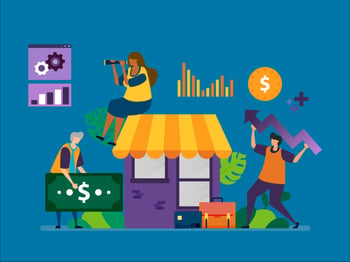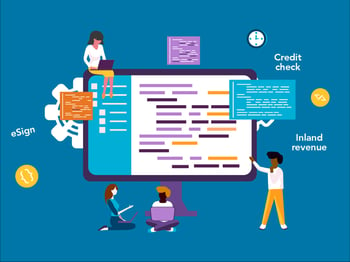You know why you want to transform your lending operations, but do you really know how?
The case for digital lending has been made. Better customer experience, improved revenues, lower risk –- by now, we’re all on board. But making the transformation from vanilla loan origination to a powerful and low-risk digital process that connects with other areas of the financial ecosystem and gobble market share? That’s much, much harder.
Q2 has partnered with a lot of organisations over the years to transform what they do for their customers. When it comes to reaching operational success, these are just some of the lessons we’ve learned along the way.
Find your North Star
What matters most to your customers? Is it time to cash? Time to ‘yes’? Do they want a loan alongside other products? Do they want more help with applications? Before you transform your lending operation, you need to know what your customers want, and you need to make it your North Star. Whenever your transformation project seems tough –- and it will –- this is what you return to and follow.
Don’t hold back on automation
Look at the entire customer journey, end-to-end, and break it down into the smallest processes possible. Then identify every task you can automate. It’s possible to replace 80 percent or more of human touchpoints with automated processes driven by robotics and machine learning. There are opportunities to automate across the lending cycle, from determining initial communication frequency during lead sourcing, to loan tenure, know-your-customer checks, account opening, collections, and beyond.
“Human touch is just the industry’s way of saying that there’s an actual person handling deals and making decisions,” says Mukul Mittal, our Vice President of Industry Solutions, Lending. “It’s important to get the balance between human touch and automation right, especially for smaller loans where manual intervention can create a whole lot of cost and error.”
Change how you think about risk
Digital lending is typically high-speed lending. Without the proper controls, it will have higher risk. So, your risk management processes also have to go digital. With digital lending, there are more opportunities for fraud, attacks on your system, and on your partners’ systems. A low-risk digital lending capability requires intelligent warning systems based on machine learning that can scrutinise customer behaviour and alert you to oddities.
Your architecture should also integrate with third-party databases, and ideally be able to predictively model things like risk of delinquencies using deep and personal datasets. Building the way you approach risk isn’t hermetically sealed, it’s not a one-size-fits-all model that’s thrust upon you. You should always have input. “All your levels of risk tolerance can be set in a way that fits your institution. Just because it’s automated doesn’t mean it’s rigid,” says Mukul Mittal, “If it were strict, there would be depreciating levels of return. What we help clients build is a system that strikes the balance they can bear.”
And it’s not all risk management, all the time - you can use the same risk data to personalise your approach to collections and cross-selling, leading to both cost-savings and revenue enhancements.
Test small but scale early
Executing digital transformation across the entire lending cycle, in one hit, is impossible. Darpan Saini, our Senior Vice President and General Manager, points out, “It’s really important that you realise that this technology isn’t just something you can tack onto your existing processes to create deal flow. It’s a full culture change, and you can’t change the culture by changing the technology first.”
Those companies that have the most success with this kind of all-encompassing transformation pick one end-to-end area to focus on and automate simple tasks first. Risk managers will be happier if decisions requiring a high degree of judgement are left to humans, for now. And quick wins in automation will help build confidence and momentum across the business. That said, once you’re confident in your automation process, your operations team should pursue scale quickly, since the more data from across the organisation there is in the digital system, the better and faster your organisation’s insights and decision-making will be. Remember, the whole thing has to change, not just a part of it.
Partner early and often
One of the key benefits to digital lending is its ability to integrate with other products and services in the financial ecosystem, including non-banking solutions. Build your digital lending system with these integrations in mind.
Your architecture should be as open as possible to facilitate these partnerships. An open architecture will allow you to attract more customers and offer them more options or deliver greater ease with expertise that you don’t have to build in-house. Early partnerships help developers to understand how to keep processes open enough to integrate. And partnering often helps you to acquire expertise and market share you couldn’t develop on your own as quickly.
These tips will help as you consider operational processes for your digital lending transformation and beyond.
Learn more about Q2 and our approach to digital lending by visiting our Beyond Transformation web site.





